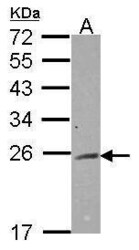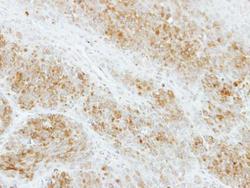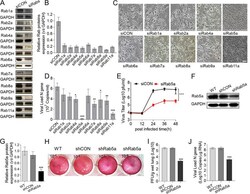Antibody data
- Antibody Data
- Antigen structure
- References [1]
- Comments [0]
- Validations
- Western blot [1]
- Immunohistochemistry [1]
- Other assay [1]
Submit
Validation data
Reference
Comment
Report error
- Product number
- PA5-30142 - Provider product page

- Provider
- Invitrogen Antibodies
- Product name
- RAB2A Polyclonal Antibody
- Antibody type
- Polyclonal
- Antigen
- Recombinant protein fragment
- Description
- Recommended positive controls: 293T. Predicted reactivity: Mouse (100%), Rat (99%), Zebrafish (100%), Xenopus laevis (88%), Dog (100%), Rabbit (100%), Chicken (100%), Rhesus Monkey (100%), Chimpanzee (100%), Bovine (100%). Store product as a concentrated solution. Centrifuge briefly prior to opening the vial.
- Reactivity
- Human
- Host
- Rabbit
- Isotype
- IgG
- Vial size
- 100 µL
- Concentration
- 0.42 mg/mL
- Storage
- Store at 4°C short term. For long term storage, store at -20°C, avoiding freeze/thaw cycles.
Submitted references Respiratory syncytial virus activates Rab5a to suppress IRF1-dependent IFN-λ production, subverting the antiviral defense of airway epithelial cells.
Mo S, Tang W, Xie J, Chen S, Ren L, Zang N, Xie X, Deng Y, Gao L, Liu E
Journal of virology 2021 Mar 25;95(8)
Journal of virology 2021 Mar 25;95(8)
No comments: Submit comment
Supportive validation
- Submitted by
- Invitrogen Antibodies (provider)
- Main image

- Experimental details
- Western Blot using RAB2A Polyclonal Antibody (Product # PA5-30142). Sample (30 µg of whole cell lysate). Lane A: 293T. 12% SDS PAGE. RAB2A Polyclonal Antibody (Product # PA5-30142) diluted at 1:1,000.
Supportive validation
- Submitted by
- Invitrogen Antibodies (provider)
- Main image

- Experimental details
- Immunohistochemical analysis of paraffin-embedded MPG xenograft, using RAB2A (Product # PA5-30142) antibody at 1:100 dilution. Antigen Retrieval: Citrate buffer, pH 6.0, 15 min.
Supportive validation
- Submitted by
- Invitrogen Antibodies (provider)
- Main image

- Experimental details
- FIG 1 Rab5a depletion reduces RSV propagation. A549 cells were transfected with either siRNA control (siCON) or specific siRNAs targeting Rab proteins (siRabs) and then infected with RSV (MOI = 0.8) as described in Materials and Methods. (A) Depletion of Rab proteins was confirmed by immunoblotting analysis of the total cell lysates. (B) Semiquantitative analysis of the data from panel A, using Image J. (C) Bright-field images of infected cell cultures, taken at 36 h p.i. Bar, 20 mum. (D) RSV propagation was scored by measuring the amount of RSV both in attached cells and released into the culture supernatants by qPCR of the RSV N gene at 36 h p.i. (E) Time course of RSV propagation at an MOI of 0.8. Female BALB/c mice, 6 to 8 weeks old, were intranasally infected with lentivirus-packaged shRNA control (shCON) or specific shRNA targeting Rab5a (shRab5a) three times and then infected with RSV as described in Materials and Methods. (F) Depletion of Rab5a was confirmed by immunoblotting analysis of the total lung lysates. (G) Semiquantitative analysis of the data from panel F, using ImageJ. (H and I) Viral titers were measured by plaque assay. (J) RSV propagation was scored by measuring the amount of RSV in lung tissue by qPCR; the values are shown as means +- standard deviations (SDs) ( n =4 to 8/group). Differences between siCON and siRab5a were analyzed for each time point by multiple t tests according to the Holm-Sidak method. ***, P < 0.0001 (for each time point from 24 h t
 Explore
Explore Validate
Validate Learn
Learn Western blot
Western blot